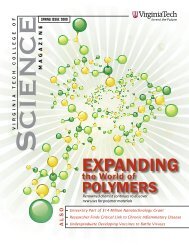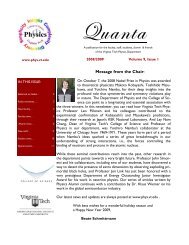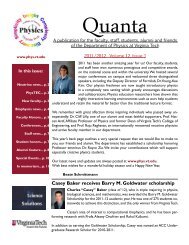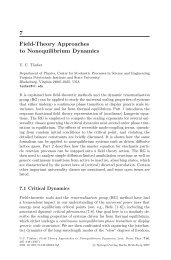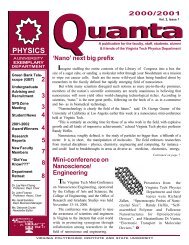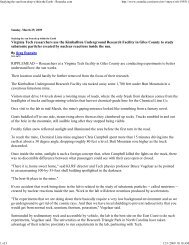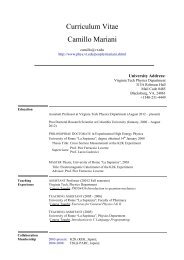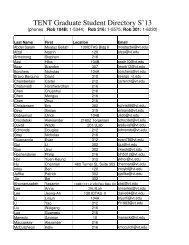College of Science Magazine, Fall 2005 - Physics - Virginia Tech
College of Science Magazine, Fall 2005 - Physics - Virginia Tech
College of Science Magazine, Fall 2005 - Physics - Virginia Tech
You also want an ePaper? Increase the reach of your titles
YUMPU automatically turns print PDFs into web optimized ePapers that Google loves.
<strong>Science</strong> Goes Underground / Hope after Tragedy / Goldwater Scholars<br />
<strong>Science</strong><br />
V i r g i n i a T e c h C o l l e g e o f<br />
m a g a z i n e<br />
Shedding Light<br />
Across Disciplines<br />
Chemical and biological researchers team up<br />
to develop new light-activated cancer therapies<br />
Issue No. 1 <strong>Fall</strong> <strong>2005</strong>
Contents<br />
Features<br />
6 <strong>Science</strong> Goes Underground<br />
What can we learn by doing research underground?<br />
More than you might think.<br />
2 Shedding Light across Disciplines<br />
Chemical and biological researchers team up to develop<br />
new light-activated cancer therapies.<br />
8 Hope after Tragedy<br />
Psychologist earns national recognition for his work<br />
with child survivors <strong>of</strong> residential fires.<br />
Other stories<br />
10 Goldwater Scholars<br />
David Erickson and Sarah Koss<br />
reflect on undergraduate research.<br />
12 Patricia Caldwell<br />
Fourth generation Hokie named<br />
COS Distinguished Alum.<br />
14 News<br />
16 New Faces in COS<br />
Cluser hires exemplify research<br />
excellence and diversity.<br />
Managing Editor/Writer Catherine Doss<br />
Copy Editor Richard Lovegrove<br />
COS Names New<br />
13 Development Director<br />
Matthew banks leaves Seton Hall to<br />
become a Hokie.<br />
Photographers T. Corvin, Rick Griffiths,<br />
Michael Kiernan, John McCormick, Bob Veltri<br />
Designer Nathan Skreslet<br />
<strong>College</strong> <strong>of</strong> <strong>Science</strong> <strong>Magazine</strong> <strong>Fall</strong> <strong>2005</strong>
<strong>College</strong> <strong>of</strong> <strong>Science</strong><br />
<strong>Virginia</strong> <strong>Tech</strong><br />
Mail Code 0405<br />
Blacksburg, VA 24061<br />
540/231-5422<br />
editor.cosmag@vt.edu<br />
www.cos.vt.edu<br />
ADMINISTRATION<br />
Lay Nam Chang Dean<br />
Sheryl Ball Associate Dean for Curriculum,<br />
Instruction, and Advising<br />
George Cr<strong>of</strong>ts Associate Dean for<br />
Administration and Finance<br />
Carole Nickerson Director <strong>of</strong> Strategic<br />
Support<br />
Nancy Ross Associate Dean for Research,<br />
Graduate Studies, and Outreach<br />
Jerry Via Assistant Dean for Undergraduate<br />
Instruction<br />
Deborah S. Wilson Career Services<br />
Coordinator<br />
ADVANCEMENT<br />
Matthew Banks Director <strong>of</strong> Development<br />
Mara K. Barker Associate Director <strong>of</strong> Alumni<br />
Relations<br />
Catherine Doss Communications Manager<br />
Tim Howland Associate Director <strong>of</strong> Corporate<br />
Relations<br />
Erik Kahill Associate Director <strong>of</strong> Development<br />
DEPARTMENT HEADS<br />
Biochemistry Peter Kennelly<br />
Biological <strong>Science</strong>s Robert Jones<br />
Chemistry Joe Merola<br />
Economics Aris Spanos<br />
Geosciences Robert Tracy (interim)<br />
Mathematics John Rossi<br />
<strong>Physics</strong> Royce Zia<br />
Psychology Jack Finney<br />
Statistics Ge<strong>of</strong>frey Vining<br />
Message from the Dean<br />
“There is a single light <strong>of</strong> science, and to brighten it<br />
anywhere is to brighten it everywhere.”<br />
-Issac Asimov<br />
Dear Alumni and Friends,<br />
It is a great privilege for me to welcome you to the inaugural<br />
issue <strong>of</strong> <strong>Virginia</strong> <strong>Tech</strong>’s <strong>College</strong> <strong>of</strong> <strong>Science</strong> <strong>Magazine</strong>. We have<br />
developed this publication as a means <strong>of</strong> keeping all <strong>of</strong> you –<br />
who are arguably some <strong>of</strong> our greatest ambassadors – informed<br />
<strong>of</strong> the remarkable achievements taking place in the college.<br />
It is no coincidence that our cover story in this first issue deals<br />
with light – as a metaphor and as a phenomenon. When we take<br />
Issac Asimov’s quote above to heart, we realize that science is<br />
all about shedding light. Illuminating the previously unknown.<br />
Brightening understanding in different areas <strong>of</strong> our complex<br />
world.<br />
Light is also symbolic <strong>of</strong> the all-encompassing nature <strong>of</strong> science.<br />
<strong>Science</strong> transcends across disciplines. Our feature story on lightactivated<br />
cancer research currently underway in the college well<br />
exemplifies this notion. In addition, our story on deep underground<br />
neutrino detection indicates the breadth <strong>of</strong> our undertakings.<br />
Our disciplines, too, know no boundaries among race, culture,<br />
gender, or nationality, as you will see from the introduction<br />
<strong>of</strong> 22 new world-class faculty members in the <strong>College</strong> <strong>of</strong> <strong>Science</strong>.<br />
I encourage you to use this publication as a two-way vehicle <strong>of</strong><br />
communication. We love to hear from our alumni and friends.<br />
Please e-mail us at editor.cosmag@vt.edu and visit our website<br />
at www.cos.vt.edu. Of course, you may also write to us at<br />
<strong>College</strong> <strong>of</strong> <strong>Science</strong> <strong>Magazine</strong>, <strong>Virginia</strong> <strong>Tech</strong>, Mail Code 1036,<br />
Blacksburg, VA 24061.<br />
<strong>Virginia</strong> <strong>Tech</strong> does not discriminate against<br />
employees, students, or applicants for<br />
admission or employment on the basis<br />
<strong>of</strong> race, gender, disability, age, veteran<br />
status, national origin, religion, sexual<br />
orientation, or political affiliation. Anyone<br />
having questions concerning discrimination<br />
should contact the Office for Equal<br />
Opportunity.<br />
Sincerely,<br />
Lay Nam Chang<br />
Dean<br />
<strong>College</strong> <strong>of</strong> <strong>Science</strong><br />
<strong>College</strong> <strong>of</strong> <strong>Science</strong> <strong>Magazine</strong><br />
Issue No.1 <strong>Fall</strong> <strong>2005</strong>
<strong>College</strong> <strong>of</strong> <strong>Science</strong> <strong>Magazine</strong><br />
Issue No.1 <strong>Fall</strong> <strong>2005</strong><br />
Call it coincidence. Call it destiny.<br />
Call it good fortune. Whatever it<br />
was, when two young scientists<br />
met at new faculty orientation at <strong>Virginia</strong><br />
<strong>Tech</strong> in 1992, it was the start <strong>of</strong> something<br />
great.<br />
In the 13 years since then, Karen Brewer, pr<strong>of</strong>essor <strong>of</strong><br />
chemistry, and Brenda Winkel, pr<strong>of</strong>essor <strong>of</strong> biology, have<br />
led research teams that have developed new and potentially<br />
revolutionary ways <strong>of</strong> treating cancer in humans.<br />
A plant biologist and inorganic chemist working side-byside?<br />
It seemed an unlikely union, but when a graduate<br />
student in chemistry that same year expressed an interest<br />
in taking a biological focus in his research, the deal was<br />
sealed.<br />
Chemical and biological researchers team up to<br />
develop new light-activated cancer therapies<br />
Light absorbing unit<br />
Active sites<br />
their work focused on the other drawback with Cisplatin<br />
– that tumors can become resistant to the drug. And that’s<br />
where the beauty <strong>of</strong> having a biologist and chemist working<br />
closely together really started to show.<br />
While Winkel’s team worked on DNA interactions, Brewer’s<br />
team was busy modifying the chemical structures <strong>of</strong> the<br />
drug.<br />
Employing basic techniques that are routinely used in<br />
Winkel’s lab, doctoral student Matt Milkevitch was able<br />
to develop an assay for DNA binding activity that has now<br />
become standardized in other chemical biology labs. The<br />
team was eventually able to change the shape and basic<br />
properties <strong>of</strong> the drug molecule, thus making it unrecognizable<br />
to the tumor.<br />
Metal-based systems for delivering pharmaceuticals are<br />
a popular area <strong>of</strong> research. One reason is that metals are<br />
constantly interacting with their environments, thus their<br />
properties and reactivity can easily be changed. Metals are<br />
also advantageous because they can be made into highly<br />
colored dyes and by doing so are more easily detected.<br />
Using colored systems also helps with the team’s research<br />
into light-activated therapy.<br />
Bridge units<br />
Light absorbing unit<br />
Light<br />
Shedding across<br />
Disciplines<br />
New Molecular Structures<br />
The research team started by looking at ways to overcome<br />
some <strong>of</strong> the inherent drawbacks in the widely used cancer<br />
drug Cisplatin. One such drawback is that the drug does<br />
not dissolve well in water. This means it must be crushed<br />
and administered in suspension form, which can cause<br />
significant kidney damage.<br />
So the first thing the research team did was develop a<br />
system that would dissolve in water. Once they did that,<br />
<strong>College</strong> <strong>of</strong> <strong>Science</strong> <strong>Magazine</strong><br />
Issue No.1 <strong>Fall</strong> <strong>2005</strong>
<strong>College</strong> <strong>of</strong> <strong>Science</strong> <strong>Magazine</strong><br />
Issue No.1 <strong>Fall</strong> <strong>2005</strong><br />
Photoinitiation<br />
One <strong>of</strong> the ways <strong>of</strong> decreasing the harsh side effects <strong>of</strong><br />
chemotherapy is to deliver the therapy only to cancerous<br />
cells, thus maintaining the integrity <strong>of</strong> surrounding healthy<br />
tissue. Currently, one method that is fairly effective at more<br />
precisely targeting cancerous cells utilizes light-activated<br />
therapy. The patient (for example, one with esophageal<br />
cancer) takes the drug in pill form. It remains inert until<br />
a fiber optic bundle <strong>of</strong> light shines into the esophagus,<br />
which then activates the drug only at the location <strong>of</strong> the<br />
cancerous cells.<br />
Foundation funding to the tune <strong>of</strong> $300,000 for three<br />
years and is capturing the attention <strong>of</strong> research partners<br />
at other institutions across the country.<br />
BEFORE<br />
This is a promising therapeutic technique, but it has a few<br />
inherent problems. The main one is that because the light<br />
energy is transferred to oxygen, it is actually the oxygen<br />
that kills the cancerous cells. This treatment method is<br />
not highly effective in aggressive tumors because they are<br />
already depleted <strong>of</strong> oxygen due to their rapid replication.<br />
Vero cells. Area <strong>of</strong> light exposure in red.<br />
“I am most surprised by<br />
what you can accomplish<br />
when you use this type <strong>of</strong><br />
team approach”<br />
AFTER TREATMENT<br />
Research assistant Matthew Mongelli tests one <strong>of</strong> the luminescent samples. Photo by Michael Kiernan.<br />
Collaborative Benefits<br />
The collaborative spirit <strong>of</strong> this project has made its way<br />
throughout the chemistry and biology departments as<br />
Brewer and Winkel agree that the collaborative effort on<br />
well. Each department is receptive to hosting presentations<br />
this research has been remarkable.<br />
by the other, and Brewer and Winkel are able to serve as<br />
“This is what really sets our research apart from what you see co-advisors to students involved in their research, not always<br />
an easy administrative hoop to jump going on at medical schools,” Winkel said. “Rather than the<br />
through.<br />
“We decided to come up with some molecular systems<br />
that didn’t require oxygen, but would still be light-<br />
activated,” Brewer said.<br />
The therapy the research group has been developing utilizes<br />
a wavelength <strong>of</strong> light called the therapeutic window,<br />
which is neither absorbed nor reflected away by tissue.<br />
This is the same wavelength that one sees as red light<br />
shining through a hand covering a flashlight. By using<br />
light at this wavelength, the research team believes they<br />
can signal their manmade molecules to release cancerfighting<br />
agents at the disease site.<br />
The research team recently started a partnership with<br />
Theralase <strong>Tech</strong>nologies Inc. to design molecular systems<br />
that use light that is in the therapeutic window.<br />
Brewer and a former postdoctoral fellow, Shawn Swavey,<br />
co-hold a patent, licenses to Theralase, in this new<br />
technology. The project has received National <strong>Science</strong><br />
Dead Vero cells<br />
Live Vero cells<br />
trial and error <strong>of</strong> what works and what doesn’t, we are much<br />
more methodical so we can understand the mechanism and<br />
why things work or don’t work.”<br />
The Brewer and Winkel research effort is a classic example <strong>of</strong><br />
the way the process <strong>of</strong> university research benefits students<br />
as well as researchers. Over the past 13 years, more than 50<br />
students have been involved in the research.<br />
“With the student involvement, the project has really taken<br />
on a life <strong>of</strong> its own,” Winkel said. “They bring their own ideas<br />
and their own talents. They’re the ones who make valuable<br />
mistakes that lead us in new directions.”<br />
It is clear that Brewer and Winkel are in this project together<br />
as much for the students as for the pure research. “I never<br />
cease to be amazed by our students at <strong>Virginia</strong> <strong>Tech</strong>,” Brewer<br />
said. “We get some incredibly talented, motivated, energetic<br />
students, and if we challenge them, they really do step up<br />
to the plate. We’re willing to do what’s right for their<br />
intellectual development.”<br />
For these two talented, dedicated scientists who have spent<br />
over a decade testing and re-testing hypotheses in the<br />
world <strong>of</strong> pharmaceuticals, pr<strong>of</strong>essional life has been full <strong>of</strong><br />
surprises. But what has been their biggest source <strong>of</strong> wonder?<br />
“I am most surprised by what you can accomplish when you<br />
use this type <strong>of</strong> team approach,” Brewer said.<br />
Winkel agrees. “This partnership has been one <strong>of</strong> the most<br />
productive learning environments that I’ve ever been part <strong>of</strong>.”<br />
<strong>College</strong> <strong>of</strong> <strong>Science</strong> <strong>Magazine</strong><br />
Issue No.1 <strong>Fall</strong> <strong>2005</strong>
<strong>College</strong> <strong>of</strong> <strong>Science</strong> <strong>Magazine</strong><br />
Issue No.1 <strong>Fall</strong> <strong>2005</strong><br />
Difficult – perhaps impossible – to imagine for most <strong>of</strong> us.<br />
Now try to imagine a 30-ton device that despite its size still<br />
sees only a few per day <strong>of</strong> this tiny, weak matter. Again, a<br />
concept beyond the scope <strong>of</strong> human comprehension.<br />
But that’s what physics is all about — exploring and<br />
theorizing about the “incomprehensibles” that make up<br />
our world. And for physicists in the <strong>College</strong> <strong>of</strong> <strong>Science</strong> at<br />
<strong>Virginia</strong> <strong>Tech</strong>, some <strong>of</strong> these explorations are taking place<br />
underground … literally.<br />
The particles referred to above are called neutrinos, and<br />
they originate from the center <strong>of</strong> the sun. Neutrinos are<br />
one <strong>of</strong> the fundamental particles <strong>of</strong> the universe but also<br />
one <strong>of</strong> the least understood. They differ from electrons<br />
in that they do not carry an electric charge and can pass<br />
through great distances in matter without being affected<br />
by it.<br />
The Kimballton facility, a joint project between <strong>Virginia</strong><br />
<strong>Tech</strong> and the Naval Research Laboratory, is being<br />
constructed 1,700 feet below ground at an operating<br />
limestone mine in Giles County, Va. (about 20 minutes<br />
northwest <strong>of</strong> Blacksburg). The facility will house research<br />
related to detecting and measuring low-energy neutrinos<br />
and their properties.<br />
Why underground? Simply put, to shield detectors from<br />
cosmic ray backgrounds.<br />
<strong>Science</strong> Goes<br />
Underground<br />
Imagine something so small and so weakly interacting that 100 billion <strong>of</strong><br />
them go through your thumbnail per second and you don’t even know it.<br />
Kimballton Mine<br />
“Cosmic ray protons and neutrons are quickly attenuated<br />
as you get deeper under the Earth’s surface,” said Bruce<br />
Vogelaar, pr<strong>of</strong>essor <strong>of</strong> physics, who is leading the project.<br />
“But muons (a heavier version <strong>of</strong> an electron) continue<br />
to penetrate much deeper, and when they pass through a<br />
detector, can produce background events themselves or<br />
secondary background. So the deeper you go, the more<br />
you attenuate these muons, and the less background you<br />
have. In physics, the name <strong>of</strong> the game is to get rid <strong>of</strong> that<br />
background or the activity produced by it so you can see<br />
rare events <strong>of</strong> interest.”<br />
Studying neutrinos this way helps us understand the sun<br />
and stars and even the deep core <strong>of</strong> our Earth. But this<br />
“low-background counting” technology also provides<br />
the capability to detect extremely small trace amounts <strong>of</strong><br />
radioactivity contained in samples <strong>of</strong> material, resulting in<br />
applications for homeland security, microelectronics, and<br />
space science.<br />
Other Research<br />
But it’s not only physics that has taken an interest in Kimballton<br />
for scientific experimentation. Certain types <strong>of</strong><br />
research in geosciences, microbiology, and engineering<br />
From left Bruce Vogelaar, Robert Bodnar and mine manager<br />
Ray Roeder outside the entrance to Kimballton.<br />
Photo courtesy <strong>of</strong> Bruce Vogelaar<br />
can also benefit from an underground<br />
location. For example, researchers<br />
in geosciences are attracted to the<br />
capability to conduct research related<br />
to scales <strong>of</strong> time and space.<br />
“In a normal university lab, we can do<br />
experiments that we measure in sizes<br />
<strong>of</strong> centimeters and meters and in<br />
durations <strong>of</strong> minutes and hours,”<br />
said Robert Bodnar, University<br />
Distinguished Pr<strong>of</strong>essor <strong>of</strong> Geosciences.<br />
“But it’s difficult to ‘scale’<br />
these processes up to the real world<br />
and estimate changes, such as those<br />
in geological formations, that may<br />
occur over the course <strong>of</strong> hundreds to<br />
thousands <strong>of</strong> years and may occur at<br />
spatial scales <strong>of</strong> kilometers to tens <strong>of</strong><br />
kilometers. By setting up experiments<br />
underground that can run for years<br />
or decades, we can get a much better<br />
idea <strong>of</strong> how things behave on longerterm<br />
scales.”<br />
Bodnar said an underground environment<br />
also reduces the risk <strong>of</strong> environmental<br />
interferences that can hinder<br />
long-term experiments above ground.<br />
The Kimballton site is also desirable<br />
to a number <strong>of</strong> scientific disciplines<br />
because <strong>of</strong> its location in sedimentary<br />
rock – an environment where a wide<br />
variety <strong>of</strong> processes occur in nature.<br />
“For example, 90 percent <strong>of</strong> groundwater<br />
comes from sedimentary rock,”<br />
Bodnar said. “All petroleum deposits<br />
we produce are from sedimentary<br />
rock; the majority <strong>of</strong> underground<br />
mines in the United States are in<br />
sedimentary rock. So there is a wide<br />
breadth <strong>of</strong> research opportunities<br />
there.”<br />
Another example <strong>of</strong> the diversity <strong>of</strong><br />
research efforts that benefit from<br />
experimentation within the confines <strong>of</strong><br />
a mine is the university’s AMADEUS<br />
(Adaptive Real-Time Geological Mapping<br />
Analysis <strong>of</strong> Underground Space)<br />
project. A multidisciplinary effort<br />
among faculty from civil and environmental<br />
engineering, mining and<br />
minerals engineering, and computer<br />
science, this NSF-funded project focuses<br />
on mining safety and geological<br />
stability issues through the use <strong>of</strong><br />
computer modeling.<br />
The development <strong>of</strong> life can also be<br />
explored by looking at organisms<br />
buried hundreds <strong>of</strong> millions <strong>of</strong> years<br />
ago, and members <strong>of</strong> <strong>Virginia</strong> <strong>Tech</strong>’s<br />
<strong>Virginia</strong> Bioinformatics Institute are<br />
looking at the impact ancient waterrecharge<br />
may have had on these<br />
organisms through studies <strong>of</strong> their<br />
DNA.<br />
A Strong Partnership<br />
With internationally recognized excellence<br />
in multiple programs, <strong>Virginia</strong><br />
<strong>Tech</strong>’s foray underground seems like a<br />
natural. And the partnership with the<br />
operators <strong>of</strong> the Kimballton Mine is a<br />
win-win situation.<br />
“The idea that cutting-edge, worldclass<br />
underground science can be<br />
done locally has real appeal to the<br />
local community,” Vogelaar said.<br />
“The Kimballton facility and related<br />
research will hopefully add to the<br />
justified pride the miners already feel<br />
for this site. I think there’s opportunity<br />
for a long-term science program here.<br />
This is an investment that will grow.”<br />
While the myriad <strong>of</strong> research possibilities<br />
at Kimballton is just beginning to<br />
be explored and developed, Vogelaar’s<br />
counting <strong>of</strong> low-energy solar neutrinos<br />
carries on, looking at those “one-in-abillion.”<br />
For further information, see<br />
www.kimballton.org.<br />
<strong>College</strong> <strong>of</strong> <strong>Science</strong> <strong>Magazine</strong><br />
Issue No.1 <strong>Fall</strong> <strong>2005</strong>
<strong>College</strong> <strong>of</strong> <strong>Science</strong> <strong>Magazine</strong><br />
Issue No.1 <strong>Fall</strong> <strong>2005</strong><br />
Hope<br />
after tragedy<br />
Sobering statistics. And yet researchers in the <strong>College</strong> <strong>of</strong><br />
<strong>Science</strong>’s Department <strong>of</strong> Psychology at <strong>Virginia</strong> <strong>Tech</strong> are<br />
<strong>of</strong>fering more than a flicker <strong>of</strong> hope to families whose lives<br />
have tragically gone up in flames.<br />
Russell T. Jones, pr<strong>of</strong>essor <strong>of</strong> psychology, and his team have<br />
studied the influence <strong>of</strong> major technological and natural<br />
disasters on children’s functioning for the past 26 years. His<br />
most recent endeavor was the completion <strong>of</strong> a $1.2 million<br />
National Institutes <strong>of</strong> Mental Health (NIMH) grant assessing<br />
the impact <strong>of</strong> residential fire on children and their parents.<br />
“Residential fires are unique in that they typically impact<br />
one single family,” Jones said. “After the fire trucks are gone<br />
and the Red Cross has completed its efforts, families are<br />
basically left to fend for themselves. This isolation may lead<br />
to even greater levels <strong>of</strong> psychological distress.”<br />
Jones found in his research that fire emergencies have<br />
potentially deleterious consequences on children and their<br />
families – consequences that may continue for years after<br />
the disaster.<br />
Russell Jones (l) counsels Katie Bowyer (r), 12,<br />
<strong>of</strong> Blacksburg, while her mother, Angela (c),<br />
observes. Katie survived a tragic house fire in<br />
February <strong>2005</strong> that took the life <strong>of</strong> her grandfather.<br />
She spent four months in the hospital<br />
– most <strong>of</strong> them in critical condition – before<br />
she was able to return home and begin to put<br />
her normal life back together again.<br />
photo by John McCormick<br />
Studies show one in every five families will experience a fire in<br />
their homes. Someone is injured by fire every 37 seconds and<br />
killed by fire every three hours. About 70 percent <strong>of</strong> these fires<br />
are residential, and most could have been prevented.<br />
“We interview survivors and assess their level <strong>of</strong> psychological<br />
distress,” Jones said. “The most common pathological<br />
outcomes include depression and post-traumatic stress<br />
syndrome.”<br />
REACT<br />
Most <strong>of</strong> the children studied reported that a house fire was<br />
the most traumatizing event they had ever experienced,<br />
and 75 percent <strong>of</strong> them believed they could do nothing<br />
to prevent house fires. That’s where Jones and his clinical<br />
team go above and beyond empirical research. Through<br />
a program called REACT (Recovery Effort After Child<br />
Trauma), they provide assistance to<br />
help children and families recover<br />
from a fire.<br />
“There are currently no long-term<br />
systematic programs that we know<br />
<strong>of</strong> to assist children after a fire,” Jones<br />
said. “We hope that our model will<br />
be a template for other communities<br />
across the country.”<br />
The goal <strong>of</strong> this free program is to<br />
help children and their families overcome<br />
their physical and psychological<br />
hardships resulting from residential fire and return to<br />
their previous levels <strong>of</strong> functioning. Using cognitive behavioral<br />
strategies, the REACT team helps children and their<br />
families cope with the devastating impact <strong>of</strong> the fire.<br />
The Fear Factor<br />
“Most victims feel an unbelievable sense <strong>of</strong> loss after a fire,”<br />
Jones said. “Children typically report a number <strong>of</strong> fears.<br />
Often they are very worried they won’t survive the next<br />
time there is a fire.”<br />
The REACT team helps children feel more control over<br />
their situations by talking about and processing their fears<br />
as well as negative thoughts and memories <strong>of</strong> the event.<br />
They are also taught empowering skills such as the “stop,<br />
drop, and roll” technique and fire safety and relaxation<br />
procedures.<br />
“Fear is an important emotional aspect that can get overlooked<br />
when the adults in a family are trying to pick up the pieces and<br />
put their lives back together,” Jones said. “Many parents are not<br />
aware <strong>of</strong> what’s really going on with their kids.”<br />
Jones said a classic response to a negative event is to avoid<br />
talking about it. “We know from research that avoidance<br />
inadvertently reinforces the fear,” he said.<br />
Beyond Psychological Counseling<br />
Research shows those most likely to be injured by fire are<br />
children and the elderly, and burn injuries are the thirdleading<br />
cause <strong>of</strong> death in children each year.<br />
Many victims <strong>of</strong> fires are from low-income families. The<br />
There are currently no<br />
long-term systematic<br />
programs that we know<br />
<strong>of</strong> to assist children<br />
after a fire.<br />
REACT team assists<br />
families psychologically<br />
and helps identify service<br />
needs and connect them<br />
with resources, such<br />
as school counselors,<br />
churches, the American<br />
Red Cross, and social<br />
services.<br />
In addition to the NIMH<br />
study, two FEMA grants<br />
enabled Jones’ group to<br />
study both injured and non-injured children following<br />
fire-related trauma. He is also spearheading a project in<br />
conjunction with the Yale Child Study Center designed to<br />
treat children after a residential fire.<br />
Jones’ research and humanitarian efforts are nationally<br />
recognized. He was recently featured in a PBS documentary<br />
on young burn victims and presented some <strong>of</strong> his collaboration<br />
with Yale on C-Span at the First International<br />
Conference on Trauma and Psychosocial Issues held at the<br />
National Press Club in Washington, D.C.<br />
For Russell Jones, his personal and pr<strong>of</strong>essional priorities<br />
are children. Even though he and his wife, <strong>Virginia</strong>, a<br />
counselor, don’t have children <strong>of</strong> their own, they are<br />
actively involved in helping them.<br />
“My life’s focus is all about advocating for kids,” he said.<br />
“Children can’t speak for themselves.”<br />
For more information about REACT, contact Jones by<br />
telephone at 540/231-5934 or by e-mail at rtjones@vt.edu.<br />
<strong>College</strong> <strong>of</strong> <strong>Science</strong> <strong>Magazine</strong><br />
Issue No.1 <strong>Fall</strong> <strong>2005</strong>
10<br />
<strong>College</strong> <strong>of</strong> <strong>Science</strong> <strong>Magazine</strong><br />
Issue No.1 <strong>Fall</strong> <strong>2005</strong><br />
Reflections on the Fluid and<br />
Fascinating World <strong>of</strong> <strong>Science</strong><br />
Life at <strong>Virginia</strong> <strong>Tech</strong> extends beyond the traditional classroom for David Erickson<br />
and Sarah Koss, two undergraduate scholars in the <strong>College</strong> <strong>of</strong> <strong>Science</strong>.<br />
The <strong>College</strong> <strong>of</strong> <strong>Science</strong> (COS) is proud to be the “home” <strong>of</strong> two Barry M. Goldwater Scholarship<br />
recipients this year. David Erickson, a junior majoring in physics and math, plans to pursue a<br />
Ph.D. and ultimately conduct research and teach at the university level. Sarah Koss, a sophomore<br />
with a triple major in biology, psychology, and studio art, plans to pursue a combined M.D./<br />
Ph.D. program in the field <strong>of</strong> neuropathology.<br />
Goldwater scholars are selected for academic merit, and each is awarded up to $7,500 per year for tuition, fees, books,<br />
and room and board. Congress established the scholarship program in 1986 to honor the late Sen. Goldwater and to<br />
encourage outstanding students to pursue careers in mathematics, the natural sciences, or engineering.<br />
Erickson and Koss were among 320 Goldwater scholars chosen from an applicant field <strong>of</strong> 1,091 undergraduates across<br />
the country. We asked each <strong>of</strong> them to share their thoughts on the value <strong>of</strong> undergraduate research* and other topics that<br />
have enlightened and inspired them in their journey so far.<br />
David Erickson<br />
Undergraduate research has been one<br />
<strong>of</strong> the most important and helpful<br />
experiences in my training for a scientific<br />
career. My research has provided<br />
a fun and challenging way to broaden,<br />
yet focus, my education. I have been<br />
able to branch out and educate myself<br />
on diverse topics in hopes <strong>of</strong> better<br />
tackling one problem. Through undergraduate<br />
research I have also come<br />
to better understand what it means<br />
to be a scientist. In scientific research<br />
you must determine the problem that<br />
you want to solve as well as devise the<br />
solution, whereas in a traditional<br />
course, the problem is already well defined and thus much<br />
simpler. I find it deeply satisfying to come up with an<br />
intriguing problem that has never been investigated and<br />
search for an answer. That is what research is all about.<br />
Pr<strong>of</strong>essors Beate Schmittmann and Royce Zia in the<br />
physics department have both been excellent mentors. I<br />
didn’t know <strong>of</strong> the extreme advantages <strong>of</strong> undergraduate<br />
research until Pr<strong>of</strong>essor Schmittmann contacted and<br />
enlightened me. She encouraged me to<br />
find a research project that interested<br />
me and proposed a couple that I could<br />
work on with her. After searching, I<br />
decided to stick with her because the<br />
project was fascinating, and I knew<br />
that she would be a great adviser.<br />
Thus I began my research with two<br />
pr<strong>of</strong>essors who <strong>of</strong>ten collaborate, and<br />
I have no regrets. Both <strong>of</strong> them are<br />
always accessible and able to help me<br />
with research, classes, and general<br />
questions. They inform me <strong>of</strong> programs<br />
and scholarships that I should pursue,<br />
and I even let Pr<strong>of</strong>essor Zia talk<br />
me into taking a graduate-level course<br />
from him last fall. Both are always willing to write a letter<br />
<strong>of</strong> recommendation and help out with any application<br />
process. I truly believe that without their help I would not<br />
have won the Barry M. Goldwater Scholarship. What’s<br />
really extraordinary though is that they are more than just<br />
mentors; I consider them friends. Our interactions are<br />
not confined to research, but extend to social events and<br />
friendly conversations.<br />
* The <strong>College</strong> <strong>of</strong> <strong>Science</strong> continues to create and support programs that encourage undergraduate students to participate in the college’s research mission.<br />
More than 300 students representing all departments in the college participated in undergraduate research and field study projects last year.<br />
I would also say that the Intermediate Electricity and<br />
Magnetism course I took at VT has made an enormous<br />
impact on me. The course is part <strong>of</strong> what is known as the<br />
“junior wall” amongst the physics undergraduates because<br />
<strong>of</strong> its difficulty. It is indeed very challenging, but also<br />
rewarding and intriguing. I learned more in that course<br />
than any other; I picked up not only the basic course<br />
material but also concepts essential to upper-level mathematics<br />
and physics. A large amount <strong>of</strong> time and effort are<br />
required in order to make so many gains, but I enjoyed<br />
staying up late into the night grinding away at a problem<br />
because after solving it, I felt I had truly accomplished<br />
something.<br />
That course helped me decide that physics is what I want<br />
to do with my life; knowing that I understood a complex<br />
universal truth made me feel like a part <strong>of</strong> something<br />
bigger and more important than myself and gave me a<br />
feeling <strong>of</strong> genuine satisfaction.<br />
Sarah Koss<br />
As with most worthwhile endeavors,<br />
undergraduate research at <strong>Virginia</strong><br />
<strong>Tech</strong> has affected me in ways that were<br />
totally unpredictable. Not only have<br />
I gained respect from my pr<strong>of</strong>essors<br />
and peers as a result <strong>of</strong> successful lab<br />
work and scholarships, but I have also<br />
experienced unforeseen social and<br />
emotional developments as a result <strong>of</strong><br />
my work.<br />
As I began my work in the Harvey W.<br />
Peters Center, interaction with the<br />
other researchers was unavoidable.<br />
In high school I was very shy, and<br />
discussing and defending my own ideas among graduate<br />
students and postdoctoral students was terrifying at<br />
first. I felt that I was in way over my head, lost in a sea <strong>of</strong><br />
organic chemistry lingo that I could not decipher. However,<br />
after quickly realizing that my opinions and ideas were just<br />
as valid as those <strong>of</strong> the other members <strong>of</strong> the lab, I began<br />
to speak my mind more readily and <strong>of</strong>ten found myself<br />
engaged in heated debates.<br />
This positive aggressiveness soon spread beyond the<br />
lab, and I began to ask more questions in class and even<br />
joke around with pr<strong>of</strong>essors and add my own comments<br />
to their lectures. I did not even notice this change until<br />
I was home one weekend and my mom showed me a<br />
report that had been written about me by one <strong>of</strong> my high<br />
school teachers: “Sarah is a very bright student, but she<br />
rarely <strong>of</strong>fers her opinions in class. She always provides the<br />
right answers when called on and <strong>of</strong>fers original ideas.<br />
She should be encouraged to talk more.” I was at first<br />
surprised by these comments, but then I realized that even<br />
during my freshman year <strong>of</strong> college I rarely contributed<br />
to class discussions. After experiencing positive interactions<br />
in the lab, however, I realized that asking a question in<br />
a room <strong>of</strong> 200 students would not actually cause me to<br />
be struck down by lightning. I also now find myself<br />
feeling much more comfortable meeting new people, both<br />
in academic and social settings.<br />
Research as an undergraduate has also affected my view<br />
<strong>of</strong> science and its representation in popular culture. Having<br />
developed a hands-on understanding <strong>of</strong> the scientific<br />
method and its use in a laboratory, I am now surprised<br />
by the ways in which scientific data are presented by the<br />
media. A philosophy pr<strong>of</strong>essor at Princeton wrote in<br />
one <strong>of</strong> his books that “<strong>of</strong> course only<br />
nonscientists believe in the supposed<br />
certainty <strong>of</strong> science.”<br />
This quote perfectly sums up <strong>of</strong> the<br />
view <strong>of</strong> the general public with regards<br />
to scientists and their work – the idea<br />
that these individuals who work in a<br />
lab are slowly piecing together a puzzle<br />
<strong>of</strong> the universe in which each piece fits<br />
precisely into an ideal space, perfectly<br />
aligned with the pieces surrounding<br />
it. In fact, scientific work is filled with<br />
much more dynamic uncertainty than<br />
with the establishment <strong>of</strong> hard facts. A<br />
more appropriate metaphor in which<br />
science is compared to a puzzle should<br />
mention puzzle pieces that refuse to<br />
retain their shape and sometimes even disappear, or a<br />
picture created by the pieces that sometimes reveals a<br />
beautiful but fleeting image, or just a reflection <strong>of</strong> the<br />
viewer, or <strong>of</strong>ten shows nothing at all.<br />
My own research work has allowed me to fully grasp the<br />
fluid nature <strong>of</strong> science as it is practiced by mankind and<br />
to recognize the divide that exists between the concept <strong>of</strong><br />
“science” from the viewpoint <strong>of</strong> a researcher versus that<br />
<strong>of</strong> a layman.<br />
<strong>College</strong> <strong>of</strong> <strong>Science</strong> <strong>Magazine</strong><br />
Issue No.1 <strong>Fall</strong> <strong>2005</strong><br />
11
12<br />
<strong>College</strong> <strong>of</strong> <strong>Science</strong> <strong>Magazine</strong><br />
Issue No.1 <strong>Fall</strong> <strong>2005</strong><br />
Her great grandfather was a member <strong>of</strong> the first class <strong>of</strong><br />
<strong>Virginia</strong> <strong>Tech</strong>. More than 130 years later, Pat Caldwell is<br />
honored for her Hokie spirit.<br />
Daniel Franklin Hale from Giles County, Va., paid for his<br />
education at the <strong>Virginia</strong> Agricultural and Mechanical <strong>College</strong><br />
(later known popularly as <strong>Virginia</strong> <strong>Tech</strong>) with a steer.<br />
How did you first become involved in the<br />
university as an alum?<br />
Patricia Caldwell in New York<br />
Fourth Generation Hokie<br />
Named <strong>College</strong> <strong>of</strong> <strong>Science</strong> Distinguished Alum<br />
Caldwell: For the first 20 years after graduation, I was<br />
not very involved. Then, in the early 1990s, I was asked to<br />
come back to the university and participate in a Women<br />
in Mathematics Day held by the math department. Then I<br />
is not all that accessible. I love visiting Blacksburg, but it’s<br />
hard to get there from here.<br />
What is your vision for the <strong>College</strong> <strong>of</strong> <strong>Science</strong>?<br />
Caldwell: I think we’re a diamond in the rough. I want<br />
us to be known as the premier place academically for<br />
individuals who want to study science.<br />
What do you enjoy most about being involved<br />
in the <strong>College</strong> <strong>of</strong> <strong>Science</strong>?<br />
Caldwell: I love being part <strong>of</strong> the Alumni Roundtable. I<br />
learn so much whenever we meet. It’s a bit like going back to<br />
school. Also, I find it so rewarding to meet with students in<br />
the <strong>College</strong> <strong>of</strong> <strong>Science</strong>. They are phenomenal. It’s staggering<br />
how impressive they are as students and as individuals.<br />
What would you tell an alumnus who is<br />
considering reconnecting with the college?<br />
Caldwell: I’d say, “What’s taken you so long?” (laugh). I<br />
think <strong>Virginia</strong> <strong>Tech</strong> has something for everyone, so it really<br />
doesn’t matter what your interests are. There’s probably a<br />
program or opportunity in which you can participate.<br />
Do you take a ribbing in New York City for<br />
being a Hokie?<br />
Caldwell: No. In New York, “hokie” is an adjective, not a<br />
noun!<br />
That was in 1872. By the time his great granddaughter,<br />
was asked to participate in the <strong>College</strong> <strong>of</strong> Arts and <strong>Science</strong>s<br />
Patricia “Pat” Caldwell entered the university in 1967,<br />
Roundtable, and I’ve been active ever since.<br />
tuition had gone up just a bit. Caldwell, a native <strong>of</strong> New<br />
York, graduated with a degree in mathematics in 1971<br />
and went on to achieve success as a financial analyst and<br />
investment banker.<br />
Last spring, Caldwell, a managing director with Gordian<br />
Group LLC <strong>of</strong> New York, was the recipient <strong>of</strong> the first ever<br />
Distinguished Alumni Award from the <strong>College</strong> <strong>of</strong> <strong>Science</strong><br />
(COS). She was selected for her exceptional service to the<br />
Why do you continue to be actively involved in<br />
the <strong>College</strong> <strong>of</strong> <strong>Science</strong>?<br />
Caldwell: Quite frankly, it’s fun. It’s different from my dayto-day<br />
work. And I have always found that I get more back<br />
than I give.<br />
What do you think is the <strong>College</strong> <strong>of</strong> <strong>Science</strong>’s<br />
greatest asset?<br />
Banks Named Development Director<br />
for <strong>College</strong> <strong>of</strong> <strong>Science</strong><br />
Matthew Banks took over as director <strong>of</strong> development cent and orchestrated<br />
for the <strong>College</strong> <strong>of</strong> <strong>Science</strong> in April. In this role, Banks is a tenfold increase in gifts<br />
responsible for the planning, implementation, and from university regents.<br />
university as well as her pr<strong>of</strong>essional achievements and<br />
community service.<br />
Caldwell was a long-time member <strong>of</strong><br />
<strong>Virginia</strong> <strong>Tech</strong>’s former <strong>College</strong> <strong>of</strong> Arts<br />
and <strong>Science</strong>s Alumni Roundtable<br />
and is currently chair <strong>of</strong> the COS<br />
Roundtable. In addition, she served<br />
on the <strong>Virginia</strong> <strong>Tech</strong> Foundation<br />
Caldwell: That’s easy. Dean Chang. He is what I would call<br />
a Renaissance dean. He has a genuine interest in all kinds<br />
<strong>of</strong> learning. I’m just as comfortable listening to him explain<br />
a concept in physics as I am talking with him about good<br />
restaurants in New York. Fundamentally, I think he<br />
represents the best there is in academia. He is an inspiring<br />
person, and I like that he has very high ambitions for the<br />
college. It’s easy to be enthusiastic around him.<br />
executive management <strong>of</strong> fundraising efforts from<br />
all private sources to support current operations,<br />
endowment, and other capital purposes in the college.<br />
“I am very excited to be a part <strong>of</strong> the COS team,” Banks<br />
said. “The college’s value to the <strong>Virginia</strong> <strong>Tech</strong> community,<br />
every <strong>Virginia</strong> <strong>Tech</strong> student, and, arguably, the world,<br />
is something in which all <strong>of</strong> its alumni, friends, and<br />
constituents vest themselves. And as the college moves<br />
From 2001 to 2002,<br />
Banks was a campaign<br />
director for Community<br />
Counseling Service Inc.<br />
<strong>of</strong> New York, a leading<br />
fundraising consulting<br />
firm to the nonpr<strong>of</strong>it<br />
sector. In this role, he<br />
Matthew Banks<br />
David Franklin Hale<br />
in his 1875 cadet<br />
<strong>of</strong>ficer graduation<br />
photo. Courtesy VT Photo<br />
Archive.<br />
board and is currently a member<br />
<strong>of</strong> the university’s capital campaign<br />
steering committee. To date, seven<br />
students in the COS have received<br />
scholarship money in her name.<br />
Recently, we asked Pat to share<br />
her thoughts on being actively<br />
involved with the university and her<br />
visions for the <strong>College</strong> <strong>of</strong> <strong>Science</strong>.<br />
Following is an excerpt from that<br />
interview.<br />
Other assets?<br />
Caldwell: Oh, lots. But in large part, it comes back to the<br />
people in the college. Both faculty and students. We have<br />
some <strong>of</strong> the best. I also enjoy the alumni who participate<br />
in the roundtable. They are such an interesting, committed<br />
group <strong>of</strong> people.<br />
What do you see as some <strong>of</strong> the challenges<br />
facing the <strong>College</strong> <strong>of</strong> <strong>Science</strong>?<br />
Caldwell: I think a challenge is that <strong>Virginia</strong> <strong>Tech</strong> is known<br />
for its engineering or athletic programs and not perceived as<br />
a university. Also, I think location is a challenge. Blacksburg<br />
forward, I am confident our efforts will benefit greatly<br />
the education and resources available for all <strong>Virginia</strong><br />
<strong>Tech</strong> students.”<br />
Banks brings eight years <strong>of</strong> development and capital<br />
campaign experience to the college, with a track record<br />
<strong>of</strong> soliciting and securing gifts in excess <strong>of</strong> $500,000.<br />
Most recently, Banks served as senior director <strong>of</strong><br />
principal and major gifts at Seton Hall University, where<br />
he was responsible for managing principal gift activity and<br />
solicitations amongst senior university administration<br />
and the university’s board <strong>of</strong> regents. In this role, Banks<br />
increased the number <strong>of</strong> major commitments by 150 per-<br />
solicited and secured more than $3 million in major<br />
gifts and managed a campaign staff and hundreds <strong>of</strong><br />
volunteers.<br />
Banks served as development <strong>of</strong>ficer for the <strong>College</strong> <strong>of</strong><br />
the Holy Cross in Worcester, Mass., from 1997 to 1999<br />
and was an associate with the Financial Marketing Group<br />
in Worcester from 1993 to 1997.<br />
Banks received his bachelor’s degree in economics from<br />
Emory University and a master’s degree in religion from<br />
Yale University. He and his wife have one child and<br />
another one on the way.<br />
<strong>College</strong> <strong>of</strong> <strong>Science</strong> <strong>Magazine</strong><br />
Issue No.1 <strong>Fall</strong> <strong>2005</strong><br />
13
14<br />
<strong>College</strong> <strong>of</strong> <strong>Science</strong> <strong>Magazine</strong><br />
Issue No.1 <strong>Fall</strong> <strong>2005</strong><br />
NEWS<br />
IP Law Program Moves Forward<br />
A memorandum <strong>of</strong> understanding has been signed<br />
between the <strong>College</strong> <strong>of</strong> <strong>Science</strong> (COS) and the University<br />
<strong>of</strong> Richmond (U <strong>of</strong> R) to establish a pre-law program. A<br />
joint curriculum will enable students in the COS to move<br />
into law school at U <strong>of</strong> R in three years, which will lead to<br />
a bachelor’s degree from <strong>Virginia</strong> <strong>Tech</strong> and a law degree<br />
with a focus on intellectual property (IP) law.<br />
Collaborative Cancer Research Underway<br />
The <strong>College</strong> <strong>of</strong> <strong>Science</strong> is engaged in a collaborative<br />
research effort with the Lombardi Comprehensive Cancer<br />
Center at Georgetown University. This unique partnership<br />
allows for development <strong>of</strong> precision therapies for various<br />
forms <strong>of</strong> cancer using nanoscience research being<br />
conducted with the COS. By studying cells at the nano<br />
level, researchers hope to understand the similarities<br />
between various cancer cells so that therapies delivered<br />
at the Lombardi Center can target these cells even more<br />
precisely.<br />
efforts in developing and directing a graduate education<br />
program with Sungkyunkwan University in South Korea.<br />
The program enables 20 to 25 Korean economics students<br />
to come to <strong>Virginia</strong> <strong>Tech</strong> for a one-month intensive<br />
course.<br />
Geller and Brown Named<br />
Alumni Distinguished<br />
Pr<strong>of</strong>essors<br />
The <strong>Virginia</strong> <strong>Tech</strong> Board <strong>of</strong> Visitors<br />
recently bestowed the honor <strong>of</strong><br />
Alumni Distinguished Pr<strong>of</strong>essor<br />
on Scott Geller, pr<strong>of</strong>essor <strong>of</strong> psychology,<br />
and Ezra “Bud” Brown,<br />
pr<strong>of</strong>essor <strong>of</strong> mathematics.<br />
Geller’s expertise in behavioral<br />
community psychology has led<br />
him to renowned work in such<br />
areas as environmental protection,<br />
automobile safety, and occupational<br />
health.<br />
Scott Geller<br />
Bryant Named COS Outstanding<br />
Young Alumnus<br />
William S. Bryant <strong>of</strong> Alpharetta, Ga., has been named<br />
this year’s Outstanding Young Alumnus for the <strong>College</strong><br />
<strong>of</strong> <strong>Science</strong>. Bryant received his Ph.D. in chemistry from<br />
<strong>Virginia</strong> <strong>Tech</strong> in 1999 with a research concentration in<br />
the construction <strong>of</strong> nanoscale objects from molecules.<br />
While a research scientist at Minerals <strong>Tech</strong>nologies Inc.<br />
<strong>of</strong> Easton, Pa., Bryant developed unique polymer coatings<br />
for calcium carbonates and served on a research<br />
team responsible for developing nanoparticles for the<br />
polymer and sealant industries. He is currently senior<br />
business development manager for IMERYS North<br />
American Performance Minerals, a leading international<br />
supplier <strong>of</strong> high-performance minerals to the polymer<br />
and coatings markets.<br />
COS Honors Outstanding<br />
Senior and Graduate<br />
Students<br />
With a near-perfect grade point<br />
average (3.98) and an honors thesis<br />
Hochella Named <strong>Virginia</strong>’s <strong>2005</strong><br />
Outstanding Scientist<br />
Michael F. Hochella, Jr., pr<strong>of</strong>essor <strong>of</strong> geosciences in<br />
the <strong>College</strong> <strong>of</strong> <strong>Science</strong>, was recently named <strong>Virginia</strong>’s<br />
Outstanding Scientist <strong>2005</strong> by Gov. Mark R. Warner.<br />
Hochella studies the surfaces <strong>of</strong> Earth materials. He is<br />
the first person to recognize important differences in the<br />
behavior <strong>of</strong> Earth materials at the atomic scale and calls<br />
this developing field <strong>of</strong> study “nanogeoscience.” As a<br />
Humbolt Fellow, Hochella discovered heavy metals in soil,<br />
streams, and rivers as far away as 300 miles from an old<br />
copper mine in Montana. Scientists worldwide are following<br />
Hochella’s lead in studying the role small atomic scale<br />
particles play, for example, in triggering asthma attacks, allergic<br />
reactions, and transporting infectious diseases and<br />
fungus worldwide. Hochella is responsible for bringing<br />
$7 million in research to <strong>Virginia</strong>.<br />
Hochella came to <strong>Virginia</strong> <strong>Tech</strong> in 1992. He was named a<br />
pr<strong>of</strong>essor in 1996.<br />
Spanos Receives COS<br />
Award for Outreach<br />
Aris Spanos, Wilson Schmidt Chair<br />
<strong>of</strong> the Department <strong>of</strong> Economics<br />
in the <strong>College</strong> <strong>of</strong> <strong>Science</strong>, is the<br />
recipient <strong>of</strong> the college’s <strong>2005</strong><br />
Award for Outreach Excellence.<br />
Spanos was recognized for his<br />
Aris Spanos<br />
Brown’s expertise is in number<br />
theory and elliptic curves. He has<br />
been described as an extraordinary<br />
ambassador for <strong>Virginia</strong> <strong>Tech</strong><br />
and the <strong>College</strong> <strong>of</strong> <strong>Science</strong> for his<br />
remarkable ability to explain these<br />
difficult concepts to audiences <strong>of</strong><br />
all ages.<br />
Ezra “Bud” Brown<br />
Members <strong>of</strong> the Frank Leigh Robeson (1904, B.S., M.E.) family<br />
gather for the dedication <strong>of</strong> a new conference room in Robeson<br />
Hall. Robeson was a pr<strong>of</strong>essor at <strong>Virginia</strong> <strong>Tech</strong> from 1904<br />
to 1954 and is credited with building the university’s physics<br />
department. Robeson Hall was named in his honor and now<br />
houses his portrait, commissioned from a Richmond artist. Pictured<br />
left to right are Robeson’s four surviving children: Andy<br />
Robeson ’48 B.S. (PHYS), emeritus pr<strong>of</strong>essor, nuclear engineering;<br />
Mary Robeson Pendelton; Amy Robeson Sjogren; and Martha<br />
Robeson ’42 B.S. (PHYS). Another daughter, Helen Robeson<br />
’34 B.S. (BIOL), died in 2000.<br />
on the topic <strong>of</strong> university budgeting,<br />
Brandon Bull <strong>of</strong> Riner, Va., was<br />
named Outstanding Senior for the<br />
<strong>College</strong> <strong>of</strong> <strong>Science</strong> last spring. Bull<br />
was a double major in economics<br />
and political science.<br />
Also last spring, Sara Haden, a<br />
native <strong>of</strong> Washington, D.C., was<br />
named Outstanding Graduate<br />
Student in the <strong>College</strong> <strong>of</strong> <strong>Science</strong>.<br />
Haden is a third-year doctoral<br />
candidate in psychology. Her major<br />
area <strong>of</strong> research is biological theories<br />
<strong>of</strong> aggression and violence.<br />
Her scholarship includes seven<br />
peer-reviewed articles in press, six<br />
works in progress, and 20 presentations<br />
across the United States<br />
and Canada. A recent review paper,<br />
authored by Haden, was accepted<br />
for national publication on its first<br />
submission.<br />
Brandon Bull<br />
Sara Haden<br />
VTalumnNET<br />
As a <strong>Virginia</strong> <strong>Tech</strong> alumnus, did you know<br />
that you have an opportunity to take a free,<br />
non-credit course every year?<br />
Whether you have wanted to add bluegrass<br />
rhythm guitar to your musical talents or<br />
learn more about the Civil War, VTalumnNET<br />
serves as the virtual gateway to more than 50<br />
courses.<br />
Most courses are self-directed, allowing individuals<br />
to move through the materials at their<br />
own leisure and to return to the content any<br />
time they choose for up to one year after enrolling.<br />
To learn more about VTalumnNET and<br />
to enroll, visit www.alumni.iddl.vt.edu<br />
or call 540/231-1264.<br />
<strong>College</strong> <strong>of</strong> <strong>Science</strong> <strong>Magazine</strong><br />
Issue No.1 <strong>Fall</strong> <strong>2005</strong><br />
15
16<br />
<strong>College</strong> <strong>of</strong> <strong>Science</strong> <strong>Magazine</strong><br />
Issue No.1 <strong>Fall</strong> <strong>2005</strong><br />
Victoria Soghomonian Liwu Li Dana Hawley Hans Robinson Kirby Deater-Deckard Daniela Cimini Carla Finkielstein Jean Heremans Giti Khodaparast<br />
New Faces<br />
COS Faculty Cluster Hires Exemplify Research Excellence, Diversity<br />
The <strong>College</strong> <strong>of</strong> <strong>Science</strong> is pleased to introduce 22 new faculty members who are part <strong>of</strong> a “cluster” hiring<br />
across disciplines. Many research questions require advanced expertise from different disciplines.<br />
Cluster hiring combines experts who are eager to work together to tackle such questions.<br />
Cluster Area: Infectious Diseases<br />
Dana Hawley, Ph.D., biology<br />
Liwu Li, Ph.D., biology<br />
Dongchu Sun, Ph.D., statistics<br />
Cluster Area: Developmental <strong>Science</strong><br />
Kirby Deater-Deckard, Ph.D., psychology<br />
Jungmeen Kim, Ph.D., psychology<br />
Jeffrey Yau, Ph.D., economics<br />
Cluster Area: Computational <strong>Science</strong><br />
Eric de Sturler, Ph.D., mathematics<br />
Rahul Kulkarni, Ph.D., physics<br />
Kyunghwa Park, Ph.D., physics<br />
Jennifer Ryan, Ph.D., mathematics<br />
Diego Troya, Ph.D., chemistry<br />
Lizette Zietsman, Ph.D., mathematics<br />
Cluster Area: Cell Biology<br />
Daniela Cimini, Ph.D., biology<br />
Carla Finkielstein, Ph.D., biology<br />
Cluster Area: Ecology (Biostatistics)<br />
Chong He, Ph.D., statistics<br />
Cluster Area: Nanoscience<br />
Jean Heremans, Ph.D., physics<br />
Giti Khodaparast, Ph.D., physics<br />
Hans Robinson, Ph.D., physics<br />
Florian Shubot, Ph.D., biology<br />
Victoria Soghomonian, Ph.D., physics<br />
Dorothea Tholl, Ph.D., biology<br />
Sungsool Wi, Ph.D., chemistry
Mark your calendars!!<br />
SUMMER AROUND THE DRILLFIELD<br />
How Small Can You Go? A peek into nanotechnology at <strong>Virginia</strong> <strong>Tech</strong><br />
A special summer experience for alumni in the new alumni and<br />
conference center on the <strong>Virginia</strong> <strong>Tech</strong> campus<br />
Featuring distinguished faculty from the <strong>College</strong> <strong>of</strong> <strong>Science</strong><br />
Also enjoy the campus and environs – golf, tennis, hiking the Cascades, biking,<br />
horseback riding, tubing the New River, or just strolling around the Duck Pond<br />
Visit www.alumni.vt.edu for details and registration<br />
J u n e 2 006<br />
F u l l d e t a i l s c o m i n g s o o n ! !<br />
Moved? New e-mail?<br />
Update your information electronically at www.alumni.vt.edu/gateway<br />
Know someone who would like to receive this publication? Let us know! editor.cosmag@vt.edu<br />
<strong>College</strong> <strong>of</strong> <strong>Science</strong><br />
<strong>Virginia</strong> <strong>Tech</strong><br />
Mail Code 0405<br />
Blacksburg, VA 24061<br />
NON-PROFIT<br />
U.S. POSTAGE<br />
PAID<br />
BLACKSBURG, VA 24060<br />
PERMIT #28



